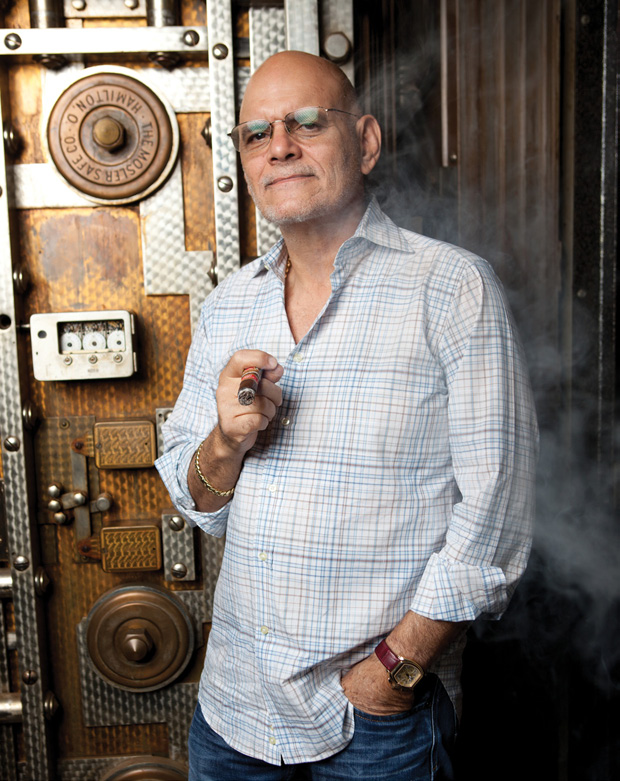EPC Cigar Co
Everything changed thanks to some drums, an audition flop, and a close encounter with an armed burglar.
Ernesto Pérez-Carrillo started playing the drums when he joined his high school band. Before long, the Cuba native who moved to Miami with his family when he was seven had fallen in love with music. It’s a love that clearly never died, as the massive safe at EPC headquarters (their building used to be a jeweler) contains—among other things—his prized collection of vinyl records.
“I started playing mostly jazz. That was what I loved playing and I’d listen to all the great jazz drummers and musicians of the era,” he said, smoking a La Historia in the sprawling lounge at the EPC office in Little Havana. “I really got kind of obsessed with it in the sense that I wanted to make that my life career.”
When Ernesto was 19, his father opened a small cigar factory in Miami. Ernesto also married his wife, who happened to be his father’s first employee. He’d split his time between work at the factory, school, and any night gigs he could get drumming. Miami’s never been a hub for aspiring jazz musicians, though.
Around 1975, Ernesto moved to New York City, hoping to make it big.
“That was the mecca of jazz. I went up there, got a day job with the Nat Sherman Townhouse and, at night, I would go out and play the clubs. One night I was playing and Stan Getz walked in,” said Ernesto. Getz is the tenor sax great best known for popularizing bossa nova—especially with his hit The Girl from Ipanema. “After he saw me play he asked if I would be interested in auditioning for his band. That was a big break for me.”
The audition at Getz’s upstate house didn’t go well. Ernesto “froze,” and Getz suggested he pick up a few more years of experience. It got Ernesto thinking this might be a sign he should follow his other passion: cigars. His time working at the factory had left him hungry for more.
“Destiny is incredible,” said Ernesto, still in awe of the sharp, fortuitous turn his life took. “I remember my mother calling me saying, ‘I think you should come back because your father is not well.’ A few days later, I remember I finished a gig and went back to the apartment where I was staying with a family in midtown New York. As I opened the door and w alked in, there was a guy there with a gun.”
Destiny is incredible.
Ernesto Pérez-Carrillo
The gun was never fired. The burglar slipped out a window. But Ernesto took the confrontation as another indication that maybe life in New York wasn’t for him. He headed back to Miami to be with his ailing father (who had ALS) and get to work on the family cigar business. Right around that time a Jamaican company offered to buy the company.
“When it hits you that you’re no longer going to be involved with cigars or tobacco, it’s kind of a wakeup call.”
Ernesto asked his dad not to sell, promising that he would commit to the company fully. Soon, he was running the factory and managing staff; by the time his father died in 1980, Ernesto was ready to lead the show. He applied lessons he’d learned from his father and other elder cigar men, but also took new steps to grow the business. Among them, attending the RTDA trade shows. After about 12 years, Cigar Aficionado came on the scene. The magazine’s first issue—released at a trade show—included a rating for La Gloria Cubana.
“All of a sudden, the La Gloria Cubana became the boutique brand of the industry.”
In three short years, Ernesto was in a position to move production to a new Dominican factory. Four years after that, the Dominican facility had quadrupled in size to 56,000 square feet. Coming to boutique prominence at the height of the cigar boom meant challenges in obtaining raw material. As luck would have it, he had good relationships with some of the biggest tobacco growing families in the game—including one that’s featured on p. 62 of this magazine.
“During that time most of the blends [on the market] were Dominican. Our blends used Dominican and Nicaraguan tobacco. In 1990, I asked the Pérez family—of ASP—to grow some Nicaraguan tobacco for me. When I started using that tobacco was when we got rated. We used also Sumatra wrapper, which wasn’t that popular at that time,” said Ernes to. “That made us unique.”
Relationships with the Pérezes, the Oliva Tobacco family, and small “chinchalero” manufacturers helped Ernesto carry his father’s company through the cigar boom of the mid 90s, especially as the La Gloria Cubana Serie R gained in popularity and became the it big-ring-gauge cigar. La Gloria had become a force nobody could ignore. General Cigar bought the brand in 1999.
Eventually, Ernesto launched EPC Cigar Company with his son Ernie Jr. and daughter Lissette. They won more loyal fans with E.P. Carrillo smokes like EPC Cardinal (which was on Cigar Snob’s list of the top 25 cigars of 2013) and Inch. These days, they’re focusing on a new brand called La Historia, for which Ernie Jr. and Lissette created the initial blends and packaging concepts. From there, father, son and daughter worked together to get all the pieces just right until, finally, they arrived at this nostalgically packaged cigar, which packs a punch without the harsh, bitter bite that’s all too common in strong cigars.
No matter what comes out of his Dominican factory, it might be a while before the guy behind Serie R and Inch shakes his reputation as the big-ring-gauge king. “I think [big ring gauges are] here to stay,” Ernesto said. “And the proof, for instance, is that our bi ggest seller in E urope and the U .S. is the Inch.”
I think big ring gauges are here to stay.
Ernesto Pérez-Carrillo
However Ernesto won’t let smokers on either side of the pond think of EPC— which will produce 2.6 million cigars this year—as a one-trick pony. He’s looking to increase his factory’s footprint, which is part of why he so values Four Kicks, Headley Grange and JD Howard—brands he creates for John Huber’s Crowned Heads.
When it comes to blending, he’s far more interested in experimenting with new seed strains and flavor profiles than in pushing the physical limits of his vitolas. He’s already got his eye on a couple of tobaccos he’s never worked with and hopes to start working them into a new blend within the next year. Knowing him, he’ll probably have another hit on his hands.




